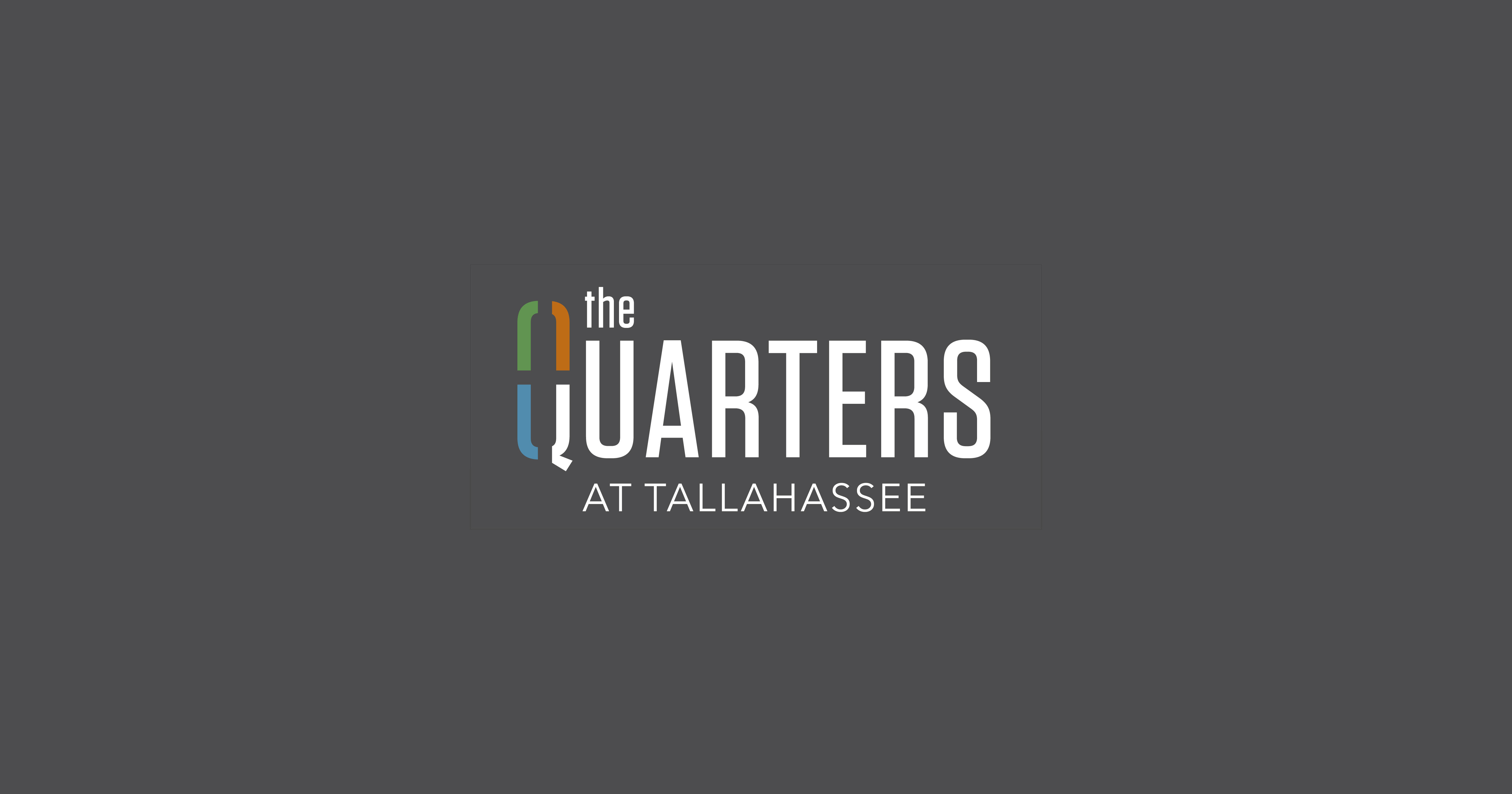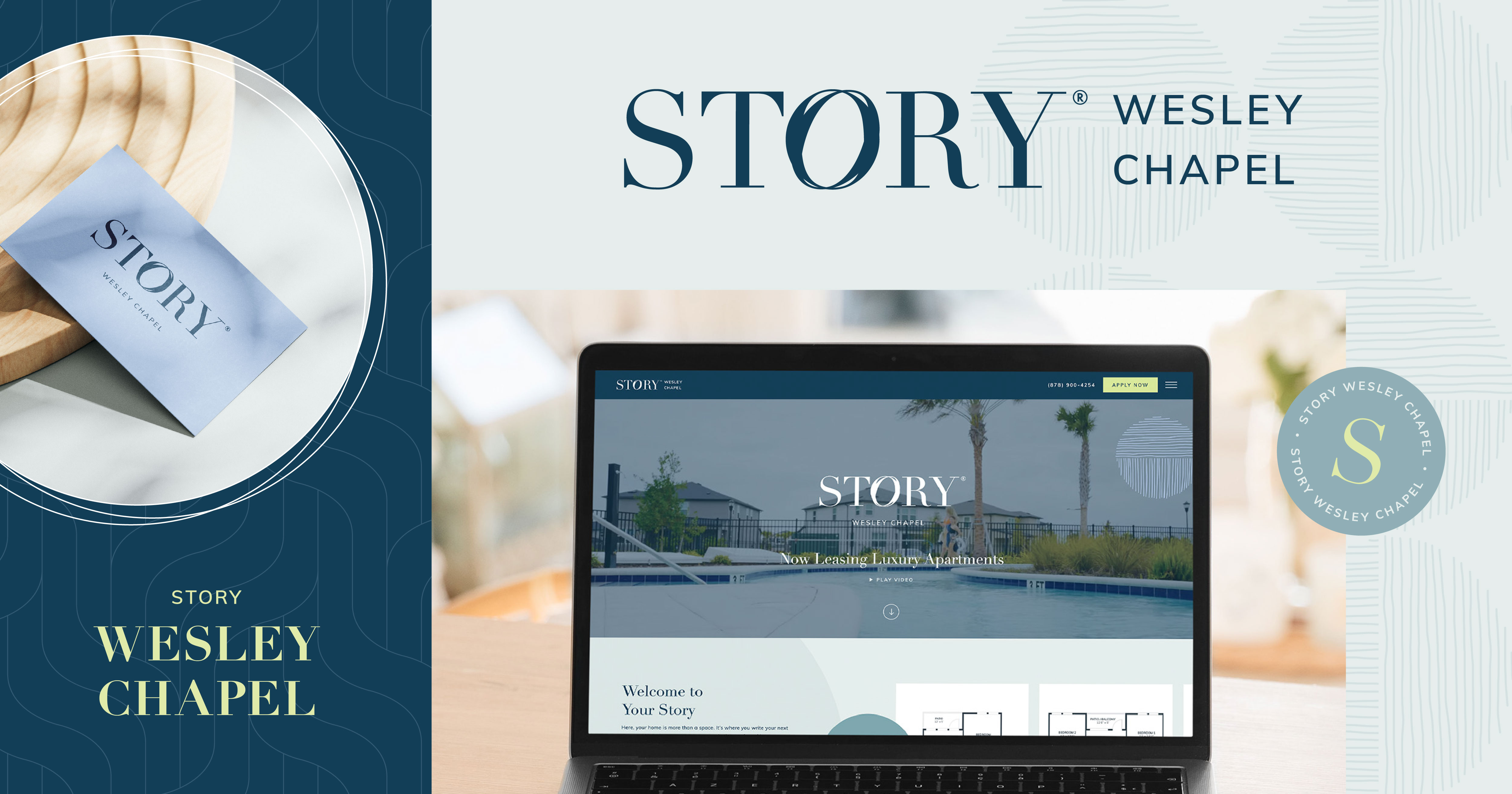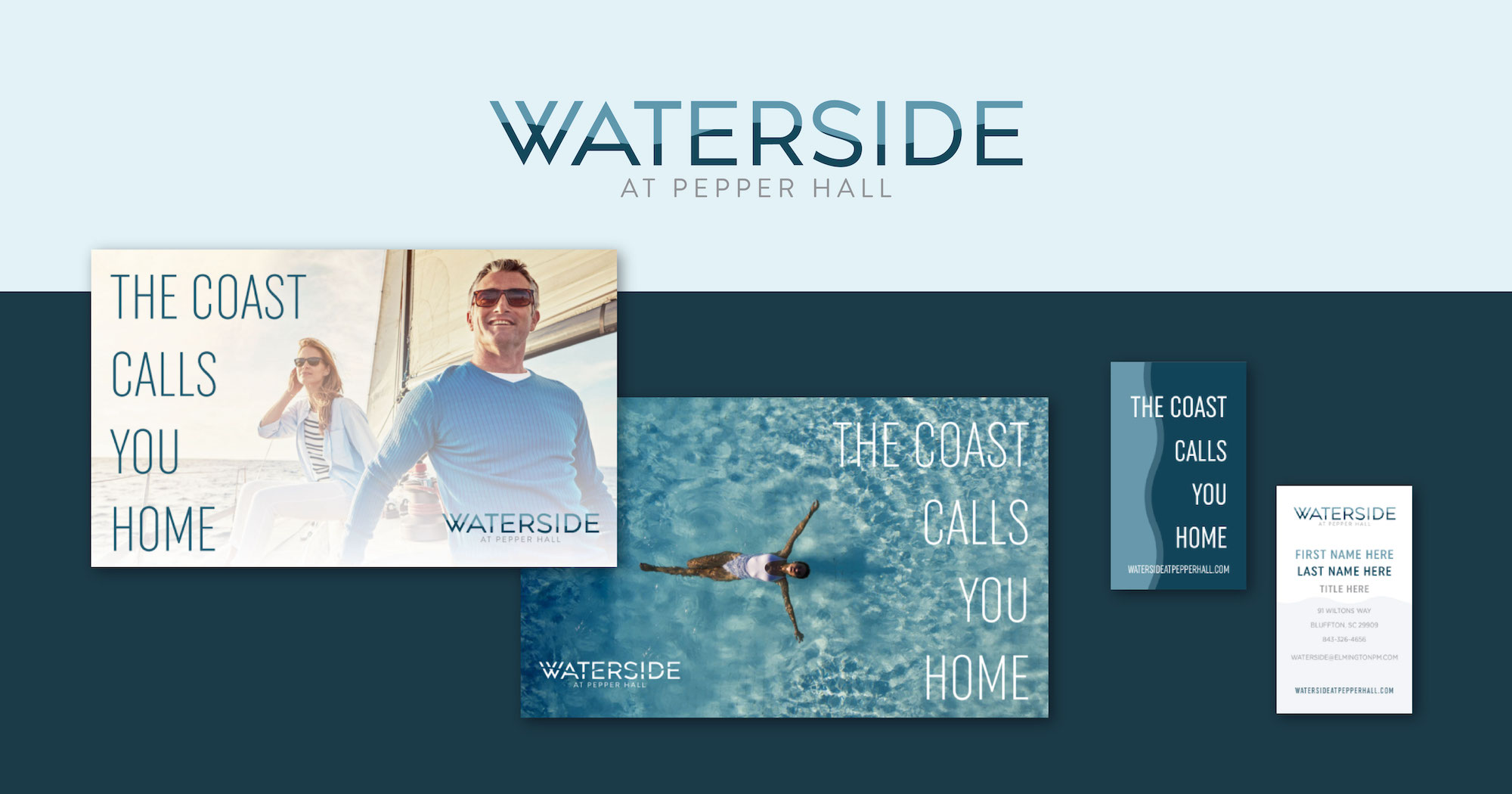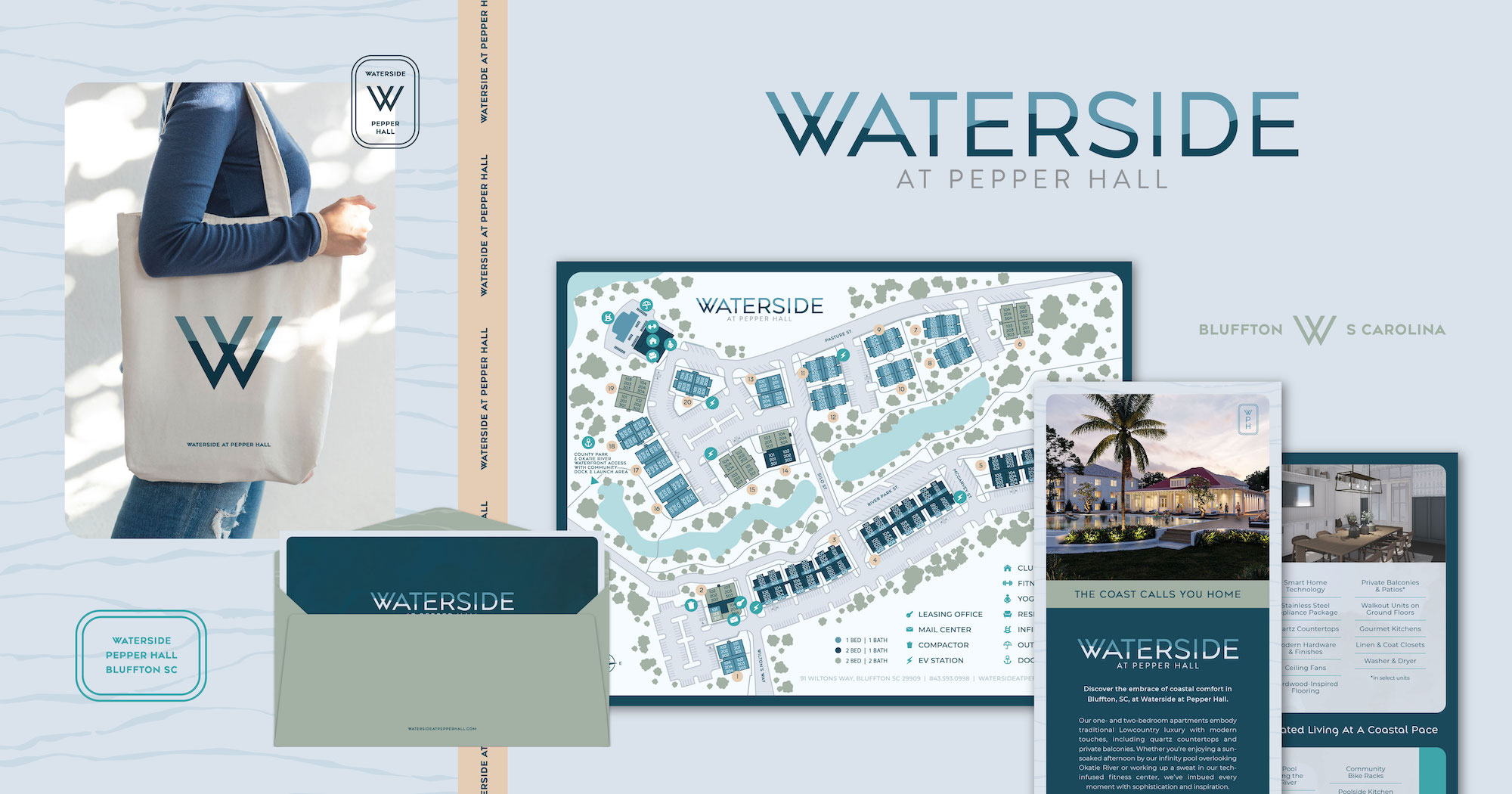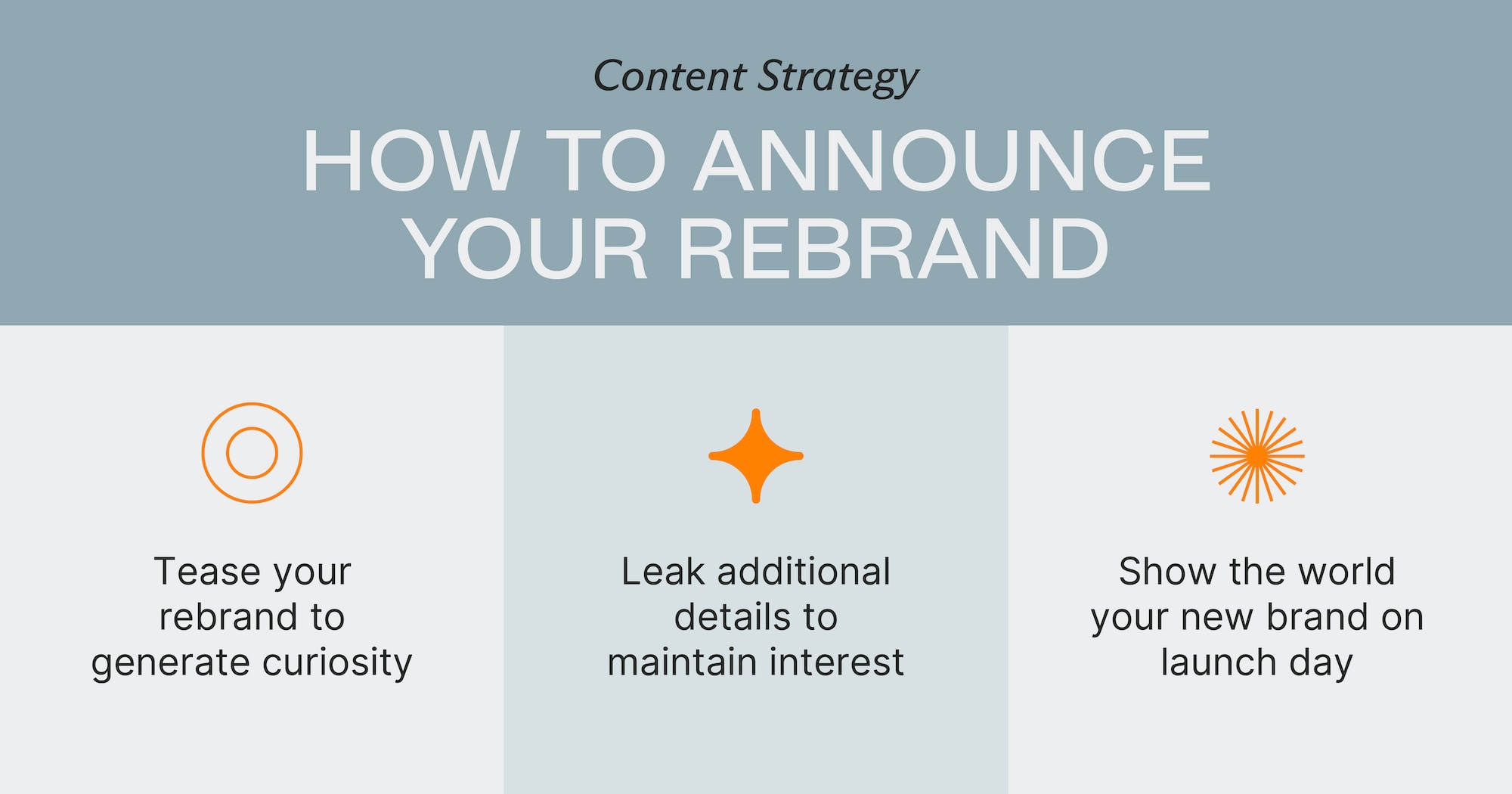How to Make a Multifamily Rebrand Work For You & Your Property

Table of Contents
When you embark on a multifamily rebrand, you aren’t just changing the look and feel of a household name, you’re changing the look and feel of a home. And whether you’re creating a whole new identity or refreshing and repositioning an existing one, you need the right strategy to make that successful.
Here, we’ll outline the basics — from doing discovery and defining goals to creating your new community logo and bringing it to life online and on-site.
How to decide if you need a multifamily rebrand
When you’re considering a rebrand for your multifamily property, the rebrand strategy should always start with:
- Understanding current brand performance: how it’s perceived and recognized, if at all
- Knowing your target audience: their ages, likes and dislikes, hobbies and lifestyles
- Understanding current brand performance: how it’s perceived and recognized, if at all
The most common reasons for rebranding include asset transitions and acquisitions, significant renovations, and implementing new marketing plans or improved leasing strategies. In all these cases, rebranding often tells your audience that improvements are coming — and that doesn’t just apply to the look. With a multifamily rebrand, residents will likely expect an improved resident experience that matches the look and feel of your brand. Think apartment or community renovations, more resident events, and/or a new management team.
When you have renovations or improvements planned already, a strategically timed rebrand shines a spotlight on them, making your community the talk of the town for current residents and prospects. They’ll all be lining up to see what’s new.
Alternatively, when properties rebrand without making changes, the rebrand itself might not make the same impact.
What type of rebranding is right for your community
With your current brand performance, target audience, and overall goal in hand, the next step is to understand what kind of property rebrand you need:
- A full rebrand is when a property changes its name, messaging, and brand strategy entirely to build a completely new identity
- A brand refresh is a strategic process that aims to shift a brand’s current image while maintaining its core identity and strategy, usually its name and possibly other elements
- A brand expansion is when a property has an existing name and logo they want to keep, but they need additional materials, like colors, patterns, messaging, and more
If the current community brand is well-known, has a high occupancy rate, and gets positive reviews online, a refresh or expansion may be the right choice to maintain all of those positive associations.
A full rebrand may be more appropriate if the brand needs repositioning in the market. This could mean it lacks unique creative qualities, a compelling story and background, or the resident experience or management team is about to change.
An ace creative team will be able to keep the logo as similar as possible while adding other exciting elements to round out the brand, like new colors, textures, patterns, and updated brand messaging.
What successful multifamily rebranding looks like
To better understand what community rebrands and refreshes look like, we curated a couple of our favorite multifamily rebranding examples done by yours truly, Agency FIFTY3.
Multifamily rebranding example
Now known as Oktiv, this community came to our team for a full rebrand that would match the energy of their Florida State University and Tallahassee State College demographic. Framed as an affordable option that wanted to feel more fun and bold, their team wanted to lean into the trendy Florida vibe with a rebrand that would determine the direction of their upcoming interior upgrades.
We gave them a new name, a color palette that connected with both colleges, and a full brand identity that could be carried through digital and print collateral as well as on-site experience.
Multifamily brand refresh example
The Story team came to us with an established logo that was already utilized in on-site signage and marketing materials, and they needed a refresh that would evolve into a successful branded house, or parent brand. It needed to be cohesive and reflective of the existing brand but updated to feel more clean and luxe.
Our Designers built a suite of logos for diverse applications, improving legibility and brand recognition across a variety of use cases. We also enhanced the color palette, added two new patterns, and created a brand voice and taglines that told their sophisticated but approachable brand story.
To date, we’ve successfully launched 7 Story communities under the refreshed parent brand, including print collateral, websites, and other digital experiences.
Multifamily brand expansion example
When our clients added Waterside at Pepper Hall to their portfolio, all it had was a logo and icon. Keeping these intact, they needed a fully built-out brand that had additional marks and graphics and adjusted colors that matched their existing logo and on-site experience. During this expansion, it was also important to note their logo and existing brand felt too beachy to reflect the reality of their low country locale.
After creating a comprehensive logo system, adjusted color palette, and new brand elements, the client said “I am immediately obsessed,” and we were contracted to do a full collateral suite to build out the brand application even more.
How to make sure digital marketing aligns with your rebrand
Even with a brand new logo and brand strategy complete — as exciting as that is — your successful multifamily rebrand is not over yet. Rebrands and refreshes affect digital strategy, SEO, paid media, social media, and reputation management.
So, once the creative is finalized, it’s time to update your digital presence to make sure the brand transition is as smooth as possible.
Website
If you’re not getting a brand new website with your rebrand (or if that deliverable is coming later), the existing website needs to be updated as soon as you launch. As the face of your brand online, your site should reflect every aspect of your new strategy: name, logo, messaging, colors, patterns, etc.
Make sure to update and quality check every detail so none of the old branding is hanging around. Even the briefest interactions matter, like the thank you page that appears after prospects submit a contact form or tour request.
Search engine optimization
When prospects search for your community, your Google Business Profile is likely the first thing they’ll see. It shows them your name, logo, website links, photography — and all of these elements are affected by and should reflect your new, cohesive brand.
So, put this high on the priority list: updating the Google Business Profile, major Internet Listing Services (ILS), and local search directory listings. Important to note: Updating core information on the Google Business Profile may trigger re-verification, so be prepared to work with your on-site team to re-verify the listing if this occurs.
If your name changes during a rebrand, it’s essential that you redirect the old website domain to the new one. With a 301 redirect, you tell Google that your web domain has officially moved to a new address, ensuring your old domain’s backlinks, authority score, and hard-earned organic rankings transfer over to the new website. Ideally, a 301 redirect should be in place for 1-2 years before removing it, and many brands choose to leave the old domain permanently redirected to avoid any potential SEO problems.
Once the 301 redirect is in place, make sure to also use the Change of Address tool in Google Search Console (GSC). This is another way to tell Google that your website has permanently changed domain names.
Paid search
With a 301 redirect, it’s important to know having a Google Ad redirect users is against terms of service and may result in campaigns being paused. So URLs used in all ad campaigns must get updated domain names.
In the cases where your name stays the same, like with a multifamily brand refresh, there’s still work to do for paid search ads.
- Update all ad copy: Make sure any old brand messaging or voice is updated, and write new copy to avoid any indications that this is the same-old brand or property as before.
- Create new visuals: For display ads or image extensions, make sure nothing has the old brand name attached, and use new images that reflect renovations and brand values.
- Build an accurate user experience: Part of Google’s job for their users is to make sure ads align well with the destination URL, so update ads to match the new brand website and messaging, keeping your ad quality score in a healthy place.
However, with lower budgets, these ads may not be served to many users, limiting the renewed brand awareness. In this case, on-site and organic social media efforts should be emphasized and encouraged to get the new name and/or brand out to your audience quickly.
Paid social media
Similar to paid search updates, the URL, ad copy, and visuals should be updated to match the new branding. But social media has a few more specifics to cross off the rebrand checklist:
- Update social media account and page names. After all, we don’t want our ad copy to promote your new name if the ad sends users to a page with a completely different name. This leads to a bad user experience and ad performance.
- Submit for approval with Meta. Whenever you request to change a page name on Instagram and Facebook, there is an approval process to go through. So the sooner you act, the better.
Organic social media
Handling organic social media rebrands needs an expert social strategy that starts early on, because this is all about communicating with people who already know your brand and/or know your area. Here are the basics we recommend in order:
- Assess your account security. Before teasing or announcing a rebrand, ensure your page security is up to date. Rebrands are important, and you only have one chance to make the announcement. So review everyone who has access to your accounts on platforms like Meta and LinkedIn, and remove any unnecessary access, updating your passwords if you haven’t done so recently.
- Plan your content timeline. Surprising your audience with a sudden rebrand announcement can make the launch feel unimportant. Instead, this three-stage process results in better engagement and recognition for your rebrand.
- Update all social media. As soon as the announcement is live, update all of your social media profiles with the new brand elements, including cover photos, profile pictures, highlight icons, hashtags, page names, and contact information.
- Coordinate your content. Moving forward, make sure upcoming posts are branded correctly and coordinate with the rest of your content strategy, like email campaigns and blog posts. By publishing all this content on the same schedule, you help deliver a comprehensive brand message and experience, getting the word out efficiently for new announcements and content.
- Maintain consistency. Or in other words, keep your momentum going! Building brand recognition means staying consistent across all platforms; this means brand voice, colors, hashtags, everything. Distinguish clearly between the old and the new brand, and stick to your new identity so people get to know it well.
Start with teasing the big announcement through subtle hints like brand colors or a new tagline. Then leak small details using sly captions, a pixelated picture of the new logo, or tell people a rebrand is coming without showing it. And then, it’s announcement time: the big day. Share all the details to round out your campaign; unveil the new logo, and discuss the reasons behind the change. This is the final stage and the time to be bold and clear.
Reputation management
Reputation management in multifamily involves campaigns to collect feedback and reviews from current or past residents, triggered by events like move-in, move-out, maintenance requests, and lease renewals.
Especially important for reputation management campaigns that are automated through software like J Turner, you need to update everywhere your old brand is represented. This means updating the name, copy, logos, and colors in all campaign emails and text messages.
How to get the on-site team involved
One of the most important and often overlooked parts of a multifamily rebrand is the on-site buildup, announcement, and result. As the operator, get the on-site team hyped for the rebrand ahead of time, and give them ways to be involved so they can communicate accurately with residents. Consider doing the following:
- Send them gift boxes with the new branded swag, and make your internal announcement exciting so this doesn’t feel like just another job requirement. After all, a rebrand is a big project that helps the on-site team succeed.
- Host a brand launch event that gets everyone involved on-site. This can bring residents, prospects, and the local community together and get the word out in an exciting way.
Get expert help for your multifamily rebrand
From your brand new logo to the strategies that make it successful online and on-site, multifamily rebrands and refreshes are huge projects. Our rebrand checklist is tailored specifically for multifamily community brands to set you up with a guideline for:
- Design and copy to-dos
- PMS and website updates
- Digital marketing essentials
- And more
And if you want more expert help, let’s dive in together to discover your current brand performance, target audience, and wildest dreams for property and brand results.
Sign up for our newsletter.
Stay in the know about our insights and industry trends.

